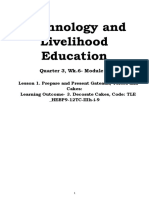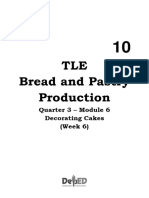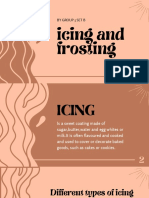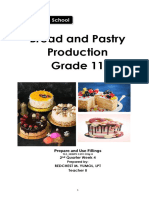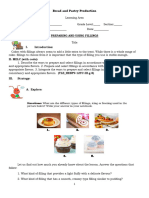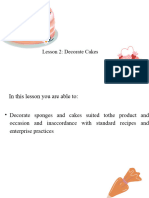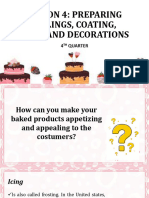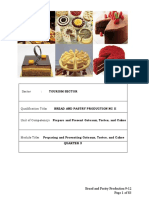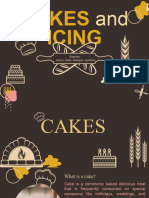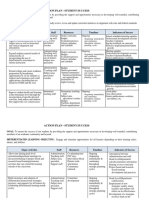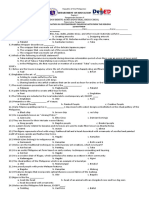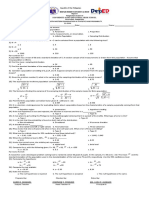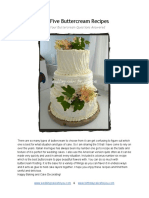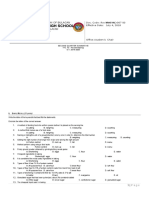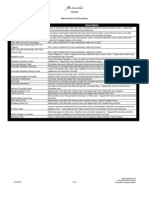TVL
Quarter 2 – Module 4
Decorating and Presenting Cakes
� What I Need to Know
This module was designed and written with you in mind. It is here to help you
master the nature of Bread and Pastry. The scope of this module permits it to
be used in many different learning situations. The language used recognizes
the diverse vocabulary level of students. The lessons are arranged to follow
the standard sequence of the course. But the order in which you read them
can be changed to correspond with the textbook you are now using.
The module is divided into two lessons, namely:
• Lesson 1 – Icing and Frosting
• Lesson 2 – Presenting and Plating Cakes
After going through this module, you are expected to:
1. Describe the different types of icing and frosting.
2. Prepare icing based on standard recipe.
3. Show correct practice in applying icing as well as to plating and
presenting cakes with patience and creativity.
1
� Lesson DECORATING AND
PRESENTING CAKES
4
There are many types of cake. Cakes with fillings always seem to add a little
extra to the treat. While there is a whole range of cake filling recipes to choose from,
it is important that the type of filling you use is stable enough.
Differentiate the pictures.
Directions: Answer the following questions on your notebook.
1. Which cup cake is more attractive?
2. Have you ever tried decorating cup cakes with icing?
3. What do you think are the ingredients needed in preparing an icing?
2
� What’s In
Directions: Re-arrange the jumbled letters to form the words being described. Write
your answer on you notebook.
1. ngici – sweet coating that covers the cake
2. gnitsorf – a term used when icing is generously applied on a cake
3. rexim cirtcele – is used to beat & blend ingredients
4. gab yrtsap – is a funnel shaped container of icing to force thru a pastry tip
5. rebbur reparcs – is used to remove sticky ingredients and mixtures from the sides
of a bowl
You will encounter these words as you continue to read this module.
What’s New
Directions: Answer the following questions. Write your answer on your notebook.
1. Why is it important to plate cakes?
2. Have you tried plating cakes?
3. Would you be able to do it if given the materials?
3
� What is It
Icing and Frosting
Meaning of Icing
Icing is a sweet coating made of sugar, butter, water, and egg whites or milk; It is
often flavored and cooked and used to cover or decorate baked goods, such as cakes
or cookies.
Different Types of Icing
Here are the most popular kinds of cake icing that you can use to finish your cakes.
1. Butter Cream
Butter cream is made of sifted powdered sugar, milk and superior butter. The
quality of butter used will reflect on the appearance, consistency and taste of your
butter cream frosting.
2. Whipped Cream
This type of cake icing is achieved using cold heavy whipping cream and sugar.
Some would advise you to use powdered sugar but ordinary granulated sugar
would work just as well.
3. Royal Icing
This type of cake icing dries into a hard outer shell. It is also one of the easiest to
dye with edible colorings. There are two ways to make this type of frosting: using
egg whites (like a meringue icing) and powdered sugar or by using meringue
powder in place of egg whites.
4. Cream Cheese Frosting
Cream cheese frosting is made with part butter cream frosting and a good quality
cream cheese. This type of frosting is usually perfect for carrot cakes, red velvet
cakes and as a filling for doughnuts and cupcakes because of its consistency.
5. Meringue
The basic ingredients for this frosting are egg whites, cold water and granulated
sugar and are one of the most common types of cake icing. It is light and fluffy
because air is introduced into the egg mixture to create a stiff consistency.
6. Fondant
This is a popular heavy frosting among celebration cakes because it is easy to
sculpt and work out. Basic fondant ingredients include gelatin, glycerine, water,
icing or castor sugar (lighter than powdered sugar) and shortening.
7. Chocolate Ganache
Chocolate ganache and glazing are probably the easiest cake icings to make.
4
�Steps and Procedures in Icing a Cake
You will need:
Cake cardboard
Cake boards come in all different sizes. Use a board that is 1-inch larger than the
cake pan. If you don’t have cake boards, a kitchen plate would be just fine.
Turntable
It is used to move cake easily in making frosting and decorating.
Cake decorating knife or Icing spatula
These are round tipped blunt knives that are essential for moving icing around and
smoothing edges. They come in bent and flat. I almost exclusively use a flat, but the
bent come in handy for smoothing the top of cakes.
Procedure in icing a cake
1. Start by taping a doily to your cake board, or kitchen plate. Place on the
revolving cake stand. .
2. Center cake on top of the cake board or kitchen plate.
3. Dollop about 3/4 cup of frosting into the center of the cake round.
5
�4. Pour about 1/2 cup to 3/4 cup of butterscotch filling into the center of the iced
layer. Using the back of a spoon, not your icing spatula, spread the filling until it
reaches the icing barrier that you have created.
5. Set aside the butterscotch topped layer for a moment. Place the second layer of
cake on a piece of waxed paper on the revolving cake stand, top side up. Trim the
cake with a serrated knife to even out the cake round just as you did with the first
layer.
6. Return the butterscotch layer to the cake stand and carefully place the second
layer, frosting side down, on top of the butterscotch filling.
6
�7. Make sure that the top of the cake is fairly even. Gently push the cake down a bit
if one side is higher than the other. Place a cup of frosting onto the center of the
cake. Using the icing spatula spread the frosting out towards the edges of the cake.
Smooth the center letting frosting accumulate at the edges of the top of the cake
if you find you have extra. The extra frosting at the edge of the cake can be used
to frost the sides of the cake.
8. Run the icing spatula under warm running water. Cleaning the knife with warm
water will help smooth the icing more easily.
7
�9. Once the sides have been frosted and smoothed, clean the icing spatula once
again.
Now your cake is ready for decoration. You can cover the cake with fondant and go
nuts.
PRESENTING AND PLATING CAKES
It is important to learn how to plate cakes properly. Pastry chefs in restaurants spend
a lot of their time to plate desserts so that they look as good as they taste.
Tips on how to plate and present cakes
1. Be creative with color
A splash of color can bring your desserts to life. A dark chocolate cake can go from
a brown lump to an artful concoction when garnished with vibrant berries; a
lemon tart goes from a fairly monotone palette to lively and lovely when presented
with the contrast of a violet flower and marbled raspberry coulis.
2. Combine textures
Adding different textures to the plate adds excitement to the visual appeal of cake.
Different textures excite the senses, giving an anticipatory sense of the taste
pleasures to come.
8
�3. Compose your plate
There are many ways to compose a plate. Consider the plate as if it were a blank
canvas or as if you were composing the frame for photograph. What would fill the
space in an interesting way?
4. Consider the vessel.
It may seem like common sense, but consider the experience of eating the
dessert when you choose the type of plate.
5. Contrast temperatures.
There’s nothing like pairing a slice of perfectly prepared cake with a cool slice of
ice cream. Combining temperatures can be a beautiful thing, but your plating does
require some consideration. Do not put your dessert on a hot plate. A slightly
chilled plate may be helpful when plating cold desserts, whereas room
temperature will do just fine for most cakes or pies.
9
�6. Let it be dramatic. Have a little fun with your cake. Employ tricks to add some
magic to the Presentation
7. Don’t make it too tall or wobbly.
A slice of layer cake looks fantastic standing up on a plate. But if it’s too tall,
there’s a strong chance of it toppling over even on a short journey to where it is
being served.
8. Garnish with care.
Keep in mind how the garnish will function on the finished plate.
9. Be consistent.
When plating cakes, be consistent in your design and in serving size. It can be
confusing to see different presentation on each plate, and nobody likes looking
over to the plate across the table and seeing a serving double the size.
What I Have Learned
When you decorate and prepare for the presentation of cakes it should be according
to the standard operating procedures and techniques.
Learn how to plate and present cake. This is your chance to develop and show your
skill and creativity.
10
� Performance Task #2
Direction: With the help of a family member who has knowledge of preparing icing,
prepare a boiled icing using the given recipe. Using a round Styrofoam or round
basin, practice and enhance your skill on icing a cake following the given steps below.
Try as many times as you can until you perfect the task.
Boiled icing
Ingredients:
4 egg whites
Procedure:
Boil sugar and water and syrup together over low fire to form a threadlike. Gradually
add to beaten egg whites. Beat until stiff. (You may use forks to beat the egg if
electric beater is not available)
Find out how well you performed by accomplishing the Scoring Rubric
honestly and sincerely. Remember it is our learning that is at stake.
11
� PERFORMANCE LEVELS
4 - Can perform this skill without supervision and with initiative and adaptability
to problem situation
3 - Can perform the skill satisfactorily without assistance or supervision
2 - Can perform the skill satisfactorily but requires some assistance and/or
supervision
1 - Can perform parts of the skill satisfactorily, but requires considerable
assistance and/or supervision
PERFORMANCE CHECKLIST 4 3 2 1
Start by taping a doily to your cake board, or kitchen
plate. Place on the revolving cake stand.
Center cake on top of the cake board or kitchen plate.
Dollop about 3/4 cup of frosting into the center of the
cake round
Pour about 1/2 cup to 3/4 cup of butterscotch filling
into the center of the iced layer.
Set aside the butterscotch topped layer for a moment.
Return the butterscotch layer to the cake stand and
carefully place the second layer, frosting side down, on
top of the butterscotch filling.
Make sure that the top of the cake is fairly even.
Run the icing spatula under warm running water.
Cleaning the knife with warm water will help smooth
the icing more easily.
Once the sides have been frosted and smoothed, clean
the icing spatula once again.



